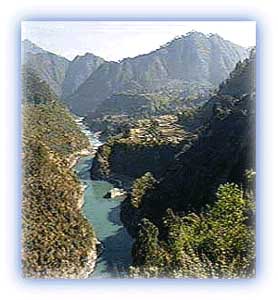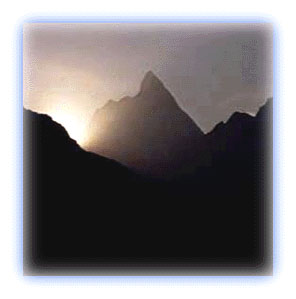Flora and fauna
General Info
· Flora
· Tropical Forests
· Temperate Forests
· Sub-alpine forests
· Alpine scrubs
· Fauna
· Mammals
· Birds
Why are these animals endangered?
How much money do the poachers make?
Protected Areas
· Nepal
· Royal Chitwan National Park
· Royal Bardiya National Park
· Mt. Everest National Park
· Langtang National Park
· Rara National Park
· Makalu-Barun National Park and Conservation Area
· Shey Phoksundo National Park
· Khaptad National Park
· Koshi Tapu Wildlife Reserve
· Parsa Wildlife Reserve
· Royal Sukla Phant Wildlife Reserve
· Dhorpatan Hunting Reserve
· Annapurna Area Conservation Project
· India
· Corbett National Park
Nanda Devi
Inner Sanctuary
Outer Sanctuary
Present day Scenario
· Kangchendzonga National Park
· Valley of Flowers
· Hemis National Park
· Pin Valley National Park

![]()
|
Nanda Devi Sanctuary The center piece of the Garhwal region is undoubtedly the Nanda Devi Sanctuary. Until 1934, the gorge of the Rishiganga river and the immediate area around Nanda Devi was one of the least known and most inaccessible parts of the Himalayas. In the Sanctuary, the mountains stand in a vast amphitheater, seventy miles in circumference and about 6000m high. There is no depression in this cirque below 5200m except in the west where the Rishi ganga has carved out for itself one of the most formidable gorges in the world. The Nanda Devi Sanctuary is drained in part, by the Alaknanda and Saraswati rivers. |
 |
| Alaknanda river, viewed from Srinagar, Garhwal. Credit: Karamjeet Singh |
The early Indian Surveyors and mountaineers alike were unable to venture into the Inner Sanctuary. It was in 1934 the Eric Shipton and Bill Tilman eventually managed to find their way to the Sanctuary. This paved the way for the Anglo-American mountain expedition of 1936 to ultimately climb the peak. When Tilman and Odell reached the top of Nanda devi on 29th August, 1936 , they had reached the highest point ever climbed by man till then. And this height record stood till the French stood on top of Annapurna in Nepal in 1950 - the first 8000m peak to be climbed by man.
Nanda Devi
Nanda Devi may not even be one of the highest twenty peaks in the world
but interestingly, at one point in time, she did enjoy
the singular status of being the highest mountain in the British empire
- the world's largest empire. The reason for this was that
Mount Everest lay in the kingdom of Nepal, and K2 lay in the princely
state of Kashmir.
Inner Sanctuary
The Inner Sanctuary bears similarity to a wrong way around letter E,
with the middle strokes made up of the twin peaks of
Nanda Devi - the main and the east peaks. The other formidable peaks
which form on the other strokes of the letter include
Latu Dhura (6392m), Sakram (6254m), Bamchu (6303m), Deo Damla (6620m),
Mangraon (6569m), Kalanka (6864m) and
Changabang (6864m). Towards the south lie peaks like Maiktoli (6803m),
Devtoli (6788m), Devistan (6678m), Panwali
Dwar (6663m) and Nanda Khat (6611m).
 |
| Nanda Devi, from Auli Credit: Karamjeet Singh |
Outer Sanctuary
The outer bastions of the Nanda devi Sanctuary is easier to enter. This
is the reason why it has provided rich pasture ground
for
shepherds for centuries. Many high Himalayan peaks lie on the outer rim
as well. These include Ronti (6063m), Nanda Ghunti
(6309m), Trishul (7120m), Bethartoli Himal (6352m), Hanuman (6075m),
Dunagiri (7066m) and Mrigthuni (6855m).
Present day Scenario
Imagine the fascination of crossing the fearsome Rishi gorge - where one
slip could mean a fall down thousands of feet down
to
the bottom of the gorge - to finally emerge into the peaceful valley of
the upper Rishi Ganga. The peak of the Nanda devi - the
goddess herself - presiding over the panorama of fantastic beauty and
piece.
When Shipton and Tilman first entered the region, there were herds of
bharal, totally unafraid at the approach of man.
Unfortunately the love of mountain beauty was short-lived. Soon after the first forays into the area, there came a large succession of army-style mountain expedition who left in their wake piles of junk and garbage on the mountain slopes.
According to news reports, Nanda Devi experienced from 1964 onwards the indignity of several hush-hush expeditions to place a nuclear spying device on her summit! Ten years later, the Sanctuary was thrown open to mountaineers. The resulting stampede of young Western climbers eager to make their marks on the mountaineering record books led to an environmental disaster.
Owing to the short season, pressure tactics were applied to get pack goats in carrying the equipment of the mountaineers. Forests were hacked to build bridges and provide fodder for the animals. Fragile juniper slopes above the tree-line were deliberately burnt to provide charcoal for the porters accompanying the mountaineering expeditions, whom the foreign expeditions had neglected to supply with warm clothes. The Indian Mountaineering Association (IMF) was itself so busy collecting peak fees from the foreign mountaineers that it neglected the area it had been created to protect. Instead of closing the sanctuary to protect its unique status , the IMF simply hiked up the fees to climb the peaks in the region.
In a few decades the Sanctuary, at its worst, resembled a combination of a garbage dump and a badly maintained public toilet, the animal life reduced to intruding man, the juniper and undergrowth mercilessly destroyed to provide firewood. Ultimately, the Sanctuary was declared a National Park. This disallows anyone to enter it. Only in the last few years, some scientific expeditions have ventured into the area to analyze the situation and also to organize clean-up operations.
All rights reserved